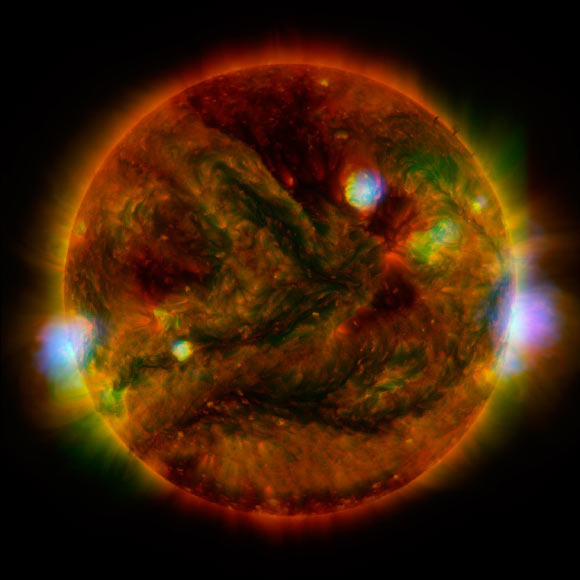Active regions of the Sun are highlighted in this composite image combining observations from a fleet of sun-monitoring satellites: NASA’s NuSTAR (Nuclear Spectroscopic Telescope Array), JAXA’s Hinode spacecraft and NASA’s SDO (Solar Dynamics Observatory).

High-energy X-rays from NuSTAR are shown in blue; low-energy X-rays from Hinode are green; and extreme UV light from SDO is yellow and red. All three telescopes captured their solar images around the same time on April 29, 2015. Image credit: NASA / JPL-Caltech / GSFC / JAXA.
“We can see a few active regions on the Sun in this view. Our Sun is quietening down in its activity cycle, but still has a couple of years before it reaches a minimum,” said Dr Iain Hannah of the University of Glasgow, who presented the image today (July 8, 2015) at the National Astronomy Meeting in Llandudno, Wales, UK.
“Those active areas of the Sun are filled with flares, which occur when magnetic field lines become tangled and broken, and then reconnect.”
Due to its extreme sensitivity, NuSTAR cannot view the larger flares. But it can help measure the energy of smaller microflares, which produce only one-millionth the energy of the larger flares.
NuSTAR may also be able to directly detect hypothesised nanoflares, which would be only one-billionth the energy of flares.
“Athough not optimized for solar observations, NuSTAR’s high sensitivity can probe previously inaccessible X-ray emission from the Sun. For instance, the weak X-ray signatures of a coronal energy release region in occulted flares or searching for the non-thermal emission from nanoflares in non-flaring active regions and the quiet Sun,” Dr Hannah and co-authors said.
“We still need the Sun to quieten down more over the next few years to have the ability to detect these events,” Dr Hannah said.
“While our Sun is approaching the tranquil end of its roughly 11-year activity cycle, it has been showing spurious bouts of high activity.”
“What’s great about NuSTAR is that the telescope is so versatile that we can hunt black holes millions of light-years away and we can also learn something fundamental about the star in our own backyard,” said co-author Dr Brian Grefenstette of the California Institute of Technology in Pasadena.
_____







